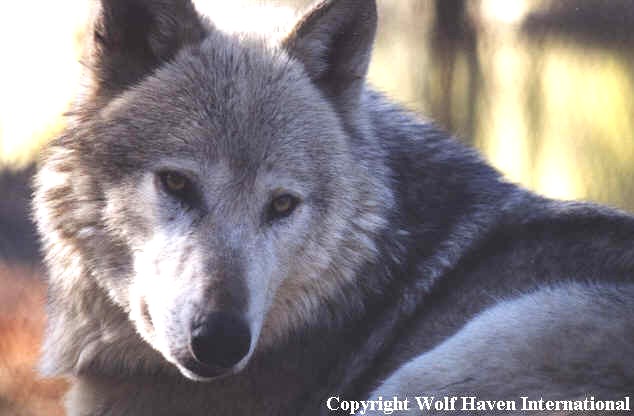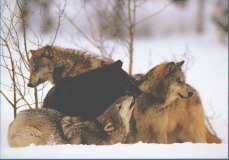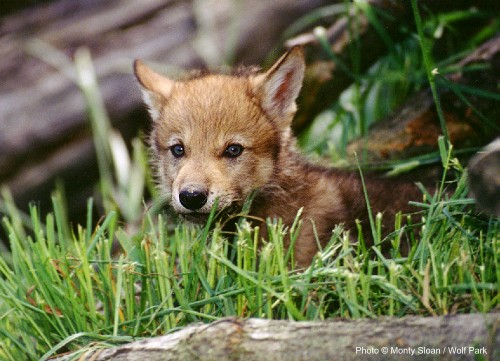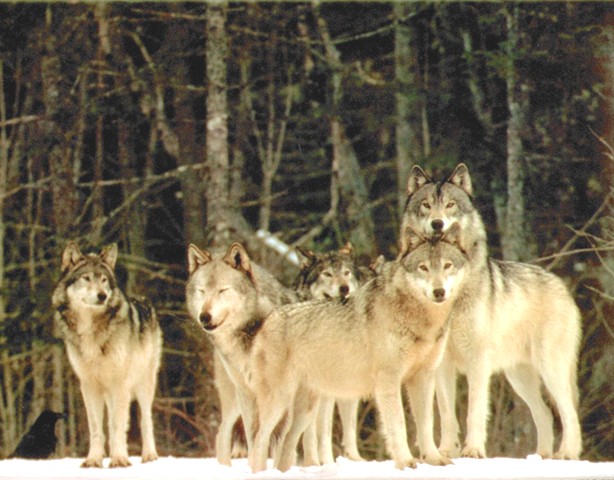

Family And Social Structure of Wolf
Because of the ways in which wolves have evolved and the special demands of their way of life, wolves have become one of the most highly social of all carnivores. Wolves live in packs - groups of animals that are usually related by close, blood ties (family units). A hierarchical order exists within the pack; every animal knows its place in that order.
Researchers studying wolves today observe the common traits shared by humans and wolves. Like many human beings, wolves live in extended families. For wolves, those families are called packs.
 Wolf
Pack
Wolf
Pack
A wolf pack is like a family unit, consisting of an adult pair and their mostly grown offspring. Members of the pack form strong social bonds that promote internal cohesion.
Wolves live in packs because cooperation allows wolves to bring down larger prey than individual wolves can do on their own. Pack life also insures the care and feeding of the young, and allows wolves to expertly defend their common territory.
Alpha Wolf
The male and female leaders of the pack are called alphas. These two animals lead the pack during a hunt and often eat first when a kill is made. Generally, though not always, the alpha wolves are the only wolves in the pack to have pups.
Beta Wolf
Next in the social hierarchy of the pack is the beta wolf. Betas can be either male or female and, if something happens to one of the alphas, it is the beta that will most likely move up in rank. the remainder of the pack is typically composed of adolescent wolves, one to four years old, several pups and an omega.
Omega Wolf
An omega wolf can be either male or female and is the scapegoat, the lowest ranking member of the pack. The omega lives on the outskirts of the pack, usually eating last. The omega serves as both a stress-reliever and instigator of play.

Breeding
When wolves become adolescents and have reached sexual maturity, many will leave their home territory in order to search for a mate. These wolves are called dispersers. The long, drawn-out howl of a 'lone wolf' will hopefully attract another unattached wolf. The two new self-proclaimed alphas find suitable territory to start a family of their own.
Wolves sexually mature at around 22 months of age and most mating take place with members of their own pack. Mating with the alpha female, by other members of the pack, is almost always forbidden. The breeding season for wolves occurs from roughly January through March, depending on the latitude. Animals in the highest latitude usually have the latest season. Pups are born in the spring (following a 63 gestation period). The entire pack takes a part in raising the young. The average litter size is four pups.
Wolf pups at birth weigh about one pound and are darkly furred. They are deaf, blind, have little or no sense of smell and cannot regulate their own body heat. For their safety, wolf pups are born in a den.

Wolf Den
Wolf dens can be in rock caves abandoned by other animals, in the hollowed bases of large trees, or in shallow surface beds. More commonly, pregnant female wolves dig dens themselves, often as early as three weeks before the pups are born. Wolves prefer their den sites to be located on elevated areas near water.
Dens are typically tunnels that extend six to fourteen feet into the earth. At the end of the tunnel is an enlarged chamber where the newborn pups are kept. The age of the pups when the pack abandons the den is not known; it is thought to be between eight and ten weeks after the pups are born.
Between the time the pups leave the den and the next winter, the young wolves remain at rendezvous sites while the adults hunt the surrounding countryside. When adults return from the hunt, the pups lick the muzzles of the adult animals, and the wolves regurgitate predigested food for the young pups.
As the pups grow, some of them will be very assertive in their play, while others in the same litter will be weaker and more submissive. Like human children, the more assertive wolf pups will grow up to be alphas while the more submissive pups will most likely grow into subordinate wolves.

Territory
Wolves occupy territories and will defend its territory against other wolves. Usually, defense requires no more than intimidating an outsider with a growling and a baring of teeth. At times a chase will ensue and in an extreme situation the chase may result in a physical confrontation. Boundaries of territories may overlap, yet separate packs will usually avoid one another at most costs.
In normal circumstances, the territory which belongs to a certain pack of wolves will remain so for many generations. Younger wolves will 'inherit' the territories belonging to their elders.
Expansion of territories depends upon land and the availability of prey. One wolf per every 10 square miles (ex: five wolves to fifty square miles) is thought of as a 'comfortable' amount of space. For some species of wolves will migrate in order to follow prey and when a pack increases in size it may split or members might disperse.
Introduction
[ What is A Wolf ? ] [ Myth And Legend of The Wolf ] [ Physiology of The Wolf ] [ Communication And Behavior of The Wolf ]
[ Family and Social Structure of The Wolf ] [ Hunting And Selection of Prey ] [ The Wolf Today ]
Poems
[ The Lone She-Wolf ] [ Fight of The Midnight Wolf ] [ The Spirit of The Wolf ] [ The Spirituality of Silent Wolf ]
[ The Lady of The Wolves ] [ The Wolf ]
Miscellaneous
[ Did You Know ? ] [ The Language of Wolves ] [ Wolves - Worldwide ] [ Questions And Answers About Wolves ]
Guest Book
[ Special Dedication ] [ Sign My Guest Book / Feedback ] [ View My Guest Book ] [ e-mail Me ]
Best view in IE5. Pentium II. True color (24 bits). Resolution 640 x 480